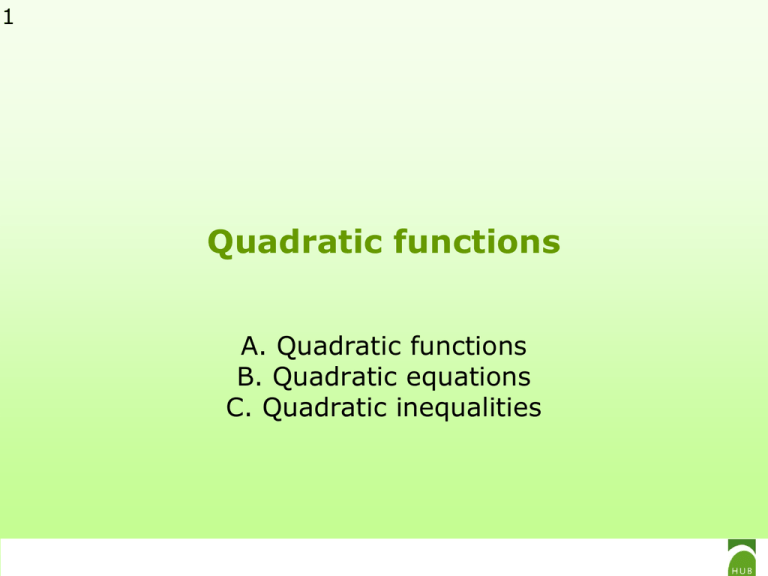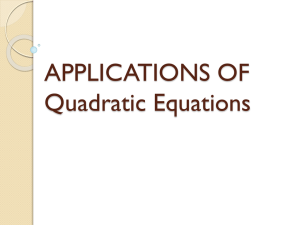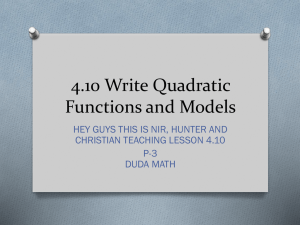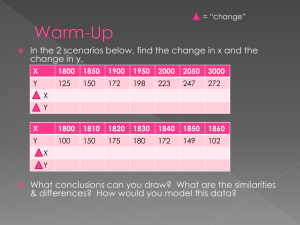Quadratic functions
advertisement

1 Quadratic functions A. Quadratic functions B. Quadratic equations C. Quadratic inequalities 2 A. Quadratic functions 3 A. Quadratic functions Example Remember exercise 4 (linear functions): For a local pizza parlor the weekly demand function is given by p=26-q/40. Express the revenue as a function of the demand q. Solution: revenue= price x quantity = 26q –q²/40 4 A. Quadratic functions Example Group excursion ♦ ♦ ♦ ♦ Minimum 20 participants Fixed cost: 122 EUR For 20 participants: 80 EUR per person For every supplementary participant: for everybody (also the first 20) a price reduction of 2 EUR per supplementary participant Revenue of the travel agency when there are 6 supplementary participants? total revenue = 122 + (20 + 6) (80 6 2) = 1890 5 A. Quadratic functions Example Group excursion ♦ ♦ ♦ ♦ Minimum 20 participants Fixed cost: 122 EUR For 20 participants: 80 EUR per person For every supplementary participant: for everybody (also the first 20) a price reduction of 2 EUR per supplementary participant Revenue y of the travel agency when there are x supplementary participants? total revenue = y = 122 + (20 + x) (80 x 2) = 2x2 + 40x + 1722 6 A. Quadratic functions revenue function y = 2x2 + 40x + 1722 is a quadratic function Definition A function f is a quadratic function if and only if its equation can be written in the form f(x) = y = ax² + bx + c where a, b and c are constants and a 0. (Section 3.3 p. 141) 7 A. Quadratic functions Example Equation: y 2 x 2 40 x 1722 Table: x 0 1 2 … y 1722 1760 1794 … Graph: PARABOLA 2000 y 500 x 10 40 8 B. Quadratic equations 9 B. Quadratic equations Example Group excursion Revenue equal to 1872? 2x² + 40x + 1722 = 1872 2x² + 40x + 1722 1872 = 0 2x² + 40x 150 = 0 We have to solve the equation 2x² + 40x 150 = 0 Quadratic equation 10 B. Quadratic equations Definition A quadratic equation is an equation that can be written in the form ax² + bx + c = 0 where a, b and c are constants and a 0. (Section 0.8 p. 36) 11 B. Quadratic equations Solving a quadratic equation - strategy 1: based on factoring, … Exercises 1. Solve x²+x12=0 (Section 0.8 – example 1 p. 36) 2. Solve (3x 4)(x+1)= 2 (Section 0.8 – example 2 p. 37) 3. Solve 4x 4x³=0 (Section 0.8 – example 3 p. 37) y 1 y 5 7(2 y 1) 4. Solve y 3 y 2 y² y 6 5. Solve x²=3 (Section 0.8 – ex. 4 p. 37) (Section 0.8 – example 5 p. 38) 12 B. Quadratic equations Solving a quadratic equation - strategy 2: formula based on the discriminant Discriminant = d = b² 4ac b d b d • if d > 0: two solutions: x1 , x2 2a 2a b • if d = 0: one solution: x 2a • if d < 0: no solutions 13 B. Quadratic equations Exercises 1. Solve 4x² - 17x + 15 = 0 (Section 0.8 – example 6 p. 36) 2. Solve 2x² + 40x 150 = 0 3. Solve 2 + 6 2 y + 9y² = 0 (example slide 9) (Section 0.8 – example 7 p. 37) 4. Solve z² + z + 1 = 0 (Section 0.8 – example 8 p. 37) 1 9 3 8 0 6 x x (Section 0.8 – example 9 p. 37) 5. Solve Supplementary exercises: exercise 1 14 A. Quadratic functions 15 A. Quadratic functions Graph Quadratic functions: graph is a PARABOLA What does the sign of a mean? ♦ if a>0, the parabola opens upward ♦ if a<0, the parabola opens downward Example (group excursion) 2000 y y = 2x² + 40x + 1722 a = 2 < 0 (Section 3.3 p. 142-144) 500 x 10 40 16 A. Quadratic functions Graph Quadratic functions: graph is a PARABOLA Graphical interpretation of y=ax²+bx+c=0? Sign of the discriminant determines the number of intersections with the horizontal axis Zero’s, also called x-intercepts, solutions of the quadratic equation y=ax²+bx+c=0, correspond to intersections with the horizontal x-axis Example Group excursion: y=-2x²+40x+1722 d=124²>0 x=41; (x=-21) 17 A. Quadratic functions Graph sign of the coefficient of x2 determines the orientation of the opening sign of the discriminant determines the number of intersections with horizontal axis 18 A. Quadratic functions Graph Quadratic functions: graph is a PARABOLA What is the Y-intercept? 2000 y Example Group excursion: y=-2x²+40x+1722 500 The y-intercept is 1722. The y-intercept is c. x 10 40 19 A. Quadratic functions Graph Each parabola is symmetric about a vertical line. Which line ? Both parabola’s at the right show a point labeled vertex, where the symmetry axis cuts the parabola. If a>0, the vertex is the “lowest” point on the parabola. If a<0, the vertex refers to the “highest” point. x-coordinate of vertex equals -b/(2a) axis of symmetry is line x=-b/(2a) x = -b/(2a) • • 20 A. Quadratic functions Example Group excursion: Maximum revenue? y 2 x 2 40 x 1722 vertex is “highest” point x-coordinate of vertex equals -b/(2a) 40 x 10 2 2 maximum revenue = y-coo of vertex = y(10) = 1922 21 A. Quadratic functions Example Group excursion: Maximum revenue? In this case you can find it e.g. using the table: So: 10 supplementary participants (30 participants in total) 22 A. Quadratic functions Exercises 1. Graph the quadratic function y = -x² - 4x + 12. Sign a? Sign d? Zeros? Y-intercept? Vertex? (Section 3.3 – example 1 p. 143) 2. A man standing on a pitcher’s mound throws a ball straight up with an initial velocity of 32 feet per second. The height of the ball in feet t seconds after it was thrown is described by the function h(t)= -16t²+32t+8 for t ≥ 0. What is the initial height of the ball? What is the maximum height? When is the ball back at a height of 8 feet? (Section 3.2 – Apply it 14 p. 144) 23 A. Quadratic functions Supplementary exercises • • • • Exercise 2 (f1 and f5), Exercise 3, 7, 5 rest of exercise 2 Exercise 4, 6, 8 and 9 24 A. Quadratic functions Supplementary exercises 2000 r Exercise 7 1500 1000 500 x 0 -500 0 -1000 200 line 400 600 800 parabola 1000 25 C. Quadratic inequalities 26 C. Quadratic inequalities Definition A quadratic inequality is one that can be written in the form ax² + bx + c ‘unequal’ 0, where a, b and c are constants and a 0 and where ‘unequal’ stands for <, , > or . Example Solve the inequality (2x 5) x 3x 14 2 i.e. find all x for which (2x 5) x 3x 14 2 standard form x 5 x 14 0 2 27 C. Quadratic inequalities Example (2x 5) x 3x 2 14 1. Write in standard form: x 5 x 14 0 2 2. Study the equality: x 5x 14 0 2 x = -2; x = 7 3. Determine type of graph: 4. Solve inequality: conclusion: x-2 or x7 interval notation: ]-,-2][7,[ 28 C. Quadratic inequalities inequalities that can be reduced to the form ax 2 bx c 0 determine the common points with the x-axis by solving the EQUATION and … 29 C. Quadratic inequalities Supplementary exercises • • • • Exercise 10 (a) Exercises 11 (a), (c) Exercises 10 (b), (c), (d) Exercises 11 (b), (d) 30 Quadratic functions Summary • Quadratic equations: discriminant d, solutions • Quadratic functions: ♦ ♦ ♦ ♦ ♦ ♦ ♦ graph: parabola sign of a sign of d zeroes vertex symmetry axis minimum/maximum • Quadratic inequalities: solutions 31 Quadratic functions Extra exercises: Handbook – Problems 0.8: Ex 31, 37, 45, 55, 57, 79 Problems 3.3: Ex 11, 13, 23, 29, 37, 41








